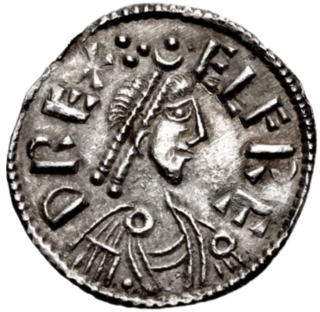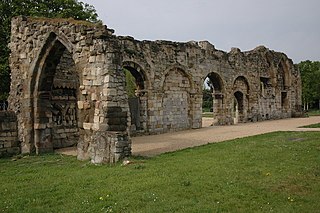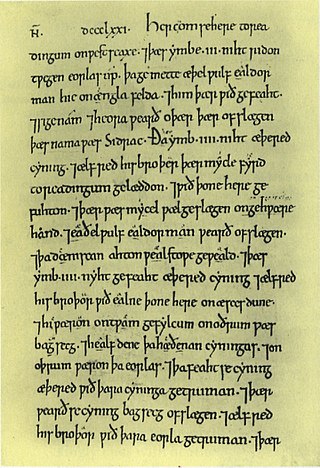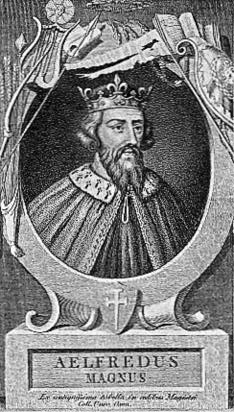
Alfred the Great was King of the West Saxons from 871 to 886, and King of the Anglo-Saxons from 886 until his death in 899. He was the youngest son of King Æthelwulf and his first wife Osburh, who both died when Alfred was young. Three of Alfred's brothers, Æthelbald, Æthelberht and Æthelred, reigned in turn before him. Under Alfred's rule, considerable administrative and military reforms were introduced, prompting lasting change in England.
The 870s decade ran from January 1, 870, to December 31, 879.

Year 871 (DCCCLXXI) was a common year starting on Monday of the Julian calendar.

Æthelred I was King of Wessex from 865 until his death in 871. He was the fourth of five sons of King Æthelwulf of Wessex, four of whom in turn became king. Æthelred succeeded his elder brother Æthelberht and was followed by his youngest brother, Alfred the Great. Æthelred had two sons, Æthelhelm and Æthelwold, who were passed over for the kingship on their father's death because they were still infants. Alfred was succeeded by his son, Edward the Elder, and Æthelwold unsuccessfully disputed the throne with him.

Æthelberht was the King of Wessex from 860 until his death in 865. He was the third son of King Æthelwulf by his first wife, Osburh. Æthelberht was first recorded as a witness to a charter in 854. The following year Æthelwulf went on pilgrimage to Rome and appointed his oldest surviving son, Æthelbald, as king of Wessex while Æthelberht became king of the recently conquered territory of Kent. Æthelberht may have surrendered his position to his father when he returned from pilgrimage, but resumed the south-eastern kingship when his father died in 858.

Ragnar Lodbrok, according to legends, was a Viking hero and a Swedish and Danish king.

The Danelaw was the part of England in which the laws of the Danes held sway and dominated those of the Anglo-Saxons. The Danelaw contrasts with the West Saxon law and the Mercian law. The term is first recorded in the early 11th century as Dena lage. The areas that constituted the Danelaw lie in northern and eastern England, long occupied by Danes and other Norsemen.
Guthrum was King of East Anglia in the late 9th century. Originally a native of Denmark, he was one of the leaders of the "Great Summer Army" that arrived in Reading during April 871 to join forces with the Great Heathen Army, whose intentions were to conquer the kingdoms of Anglo-Saxon England. The combined armies were successful in conquering the kingdoms of East Anglia, Northumbria, and parts of Mercia, and overran Alfred the Great's Wessex, but were ultimately defeated by Alfred at the Battle of Edington in 878. The Danes retreated to their stronghold, where Alfred laid siege and eventually Guthrum surrendered.

Æthelred, Lord of the Mercians became ruler of English Mercia shortly after the death or disappearance of its last king, Ceolwulf II in 879. Æthelred's rule was confined to the western half, as eastern Mercia was then part of the Viking-ruled Danelaw. His ancestry is unknown. He was probably the leader of an unsuccessful Mercian invasion of Wales in 881, and soon afterwards he acknowledged the lordship of King Alfred the Great of Wessex. This alliance was cemented by the marriage of Æthelred to Alfred's daughter Æthelflæd.

Æthelwold or Æthelwald was the younger of two known sons of Æthelred I, King of Wessex from 865 to 871. Æthelwold and his brother Æthelhelm were still infants when their father the king died while fighting a Danish Viking invasion. The throne passed to the king's younger brother Alfred the Great, who carried on the war against the Vikings and won a crucial victory at the Battle of Edington in 878.

Halfdan Ragnarsson was a Viking leader and a commander of the Great Heathen Army which invaded the Anglo-Saxon kingdoms of England, starting in 865.

The Battle of Englefield was a West Saxon victory against a Danish Viking army on about 31 December 870 at Englefield, near Reading in Berkshire. It was the first of a series of battles that took place following an invasion of Wessex by the Danish army in December 870.

The Battle of Reading was a victory for a Danish Viking army over a West Saxon force on about 4 January 871 at Reading in Berkshire. The Vikings were led by Bagsecg and Halfdan Ragnarsson and the West Saxons by King Æthelred and his brother, the future King Alfred the Great. It was the second of a series of battles that took place following an invasion of Wessex by the Danish army in December 870.

Æthelred was an Anglo-Saxon Archbishop of Canterbury in medieval England. Although one source states that he was Bishop of Wiltshire prior to his elevation to Canterbury, this has been shown to be false. Much of Æthelred's time in office was spent dealing with the dislocations caused by the invasion of England by Vikings. There were also conflicts with King Alfred the Great over ecclesiastical matters as well as the desire of the papacy to reform the English clergy.

The Great Heathen Army, also known as the Viking Great Army, was a coalition of Scandinavian warriors who invaded England in AD 865. Since the late 8th century, the Vikings had been engaging in raids on centres of wealth, such as monasteries. The Great Heathen Army was much larger and aimed to conquer and occupy the four kingdoms of East Anglia, Northumbria, Mercia and Wessex.
Ricsige was King of Northumbria from 873 to 876. He became king after Ecgberht I was overthrown and fled, with Wulfhere, Archbishop of York, to Mercia.

Bagsecg, also known as Bacgsecg, was a viking and a leader of the Great Army, which invaded England. According to the Anglo-Saxon Chronicle, Bagsecg and Healfdene were joint commanders of the Great Army that invaded the Kingdom of Wessex during the northern winter of 870/71.
Events from the 9th century in England.
The Battle of Basing was a victory of a Viking army over the West Saxons at the royal estate of Basing in Hampshire on about 22 January 871.
The Battle of Meretun between a West Saxon army led by King Æthelred and his brother, the future King Alfred the Great, and a Viking army took place on 22 March 871 at an unknown location in Wessex, probably in one of the modern counties of Dorset, Hampshire, or Wiltshire.













